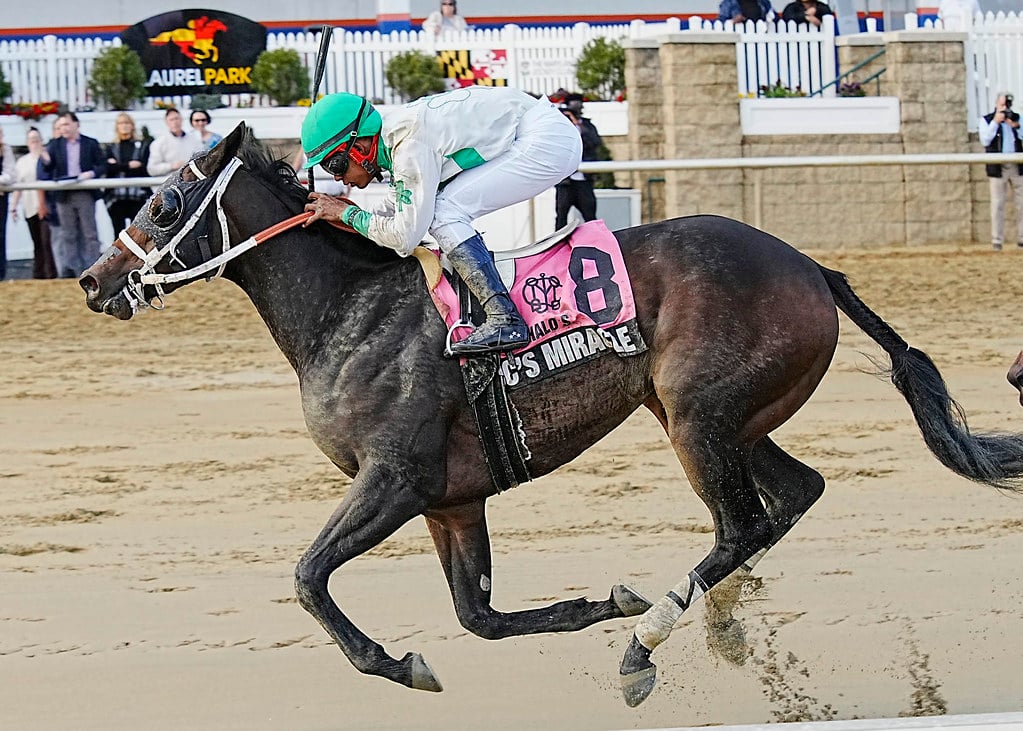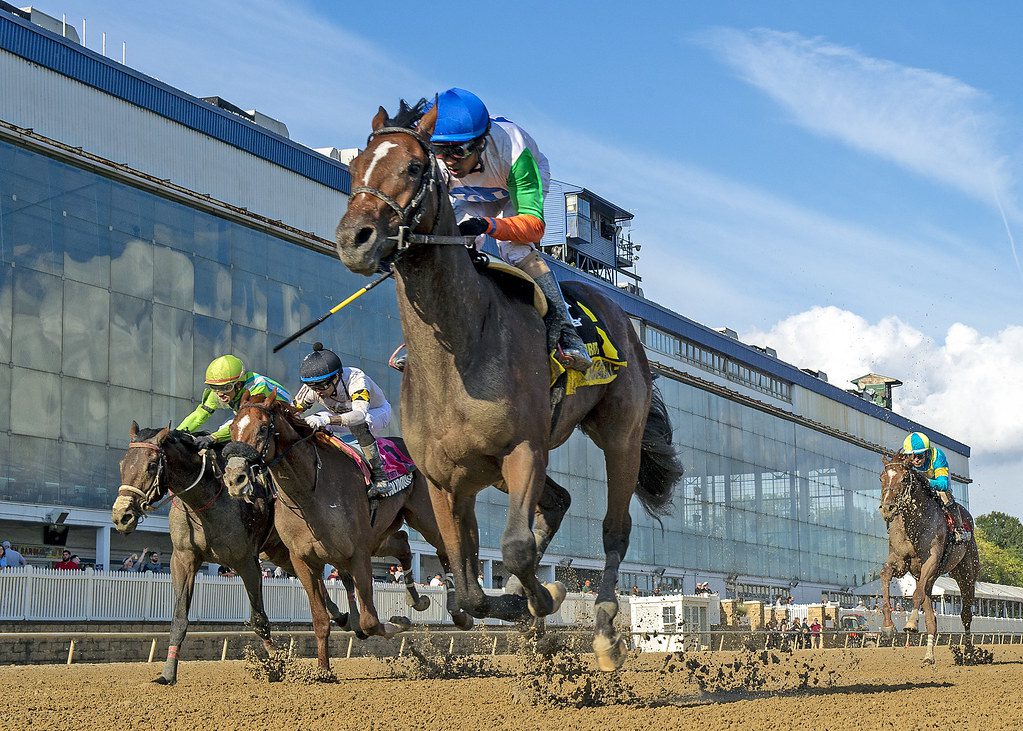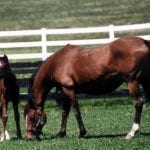[et_pb_section fb_built=”1″ _builder_version=”3.23.1″][et_pb_row column_structure=”2_5,3_5″ _builder_version=”3.25″][et_pb_column type=”2_5″ _builder_version=”3.25″ custom_padding=”|||” custom_padding__hover=”|||”][et_pb_text _builder_version=”3.27.4″]
![]()
[/et_pb_text][/et_pb_column][et_pb_column type=”3_5″ _builder_version=”3.25″ custom_padding=”|||” custom_padding__hover=”|||”][et_pb_text _builder_version=”3.27.4″]
Jack Harmon and, on the right, the Teletimer unit. Photos by The Racing Biz.
The last race at Laurel Park on January 31 was a second-level allowance/optional claimer. The winner took 1:23.98 to complete the seven-furlong journey.
And with that, Jack Harmon’s 49-year career as a racetrack timer – nearly five decades ticked off in hundredths of a second – came to an end.
“You know, the company sold out, and what can you do?” Harmon said a few days later. “You just, you just have to accept it. And yet do I miss it? Yeah.”
[/et_pb_text][et_pb_text _builder_version=”3.27.4″]
[/et_pb_text][et_pb_text admin_label=”2nd part of story” _builder_version=”4.3.2″]
The company for which Harmon worked, American Teletimer, sold its timing assets to Equibase, with the deal closing January 31. The timing system Equibase employs – which uses GPS (global positioning system) to time horses – promises to allow more individualized and greatly enhanced data collection but has struggled to find its footing.
You’ve probably never seen Harmon, or if you have, he was doing his other job, working for AmTote, the tote company that handles the Maryland tracks. He’s been doing that for nearly 30 years, too.
But it’s timing that brought him to the track out of high school.
“My father worked at a racetrack for over 40 years,” Harmon explained. “So I said, I’m going to go into the same trade as him, but it’s not going to be the same thing. He used to work for AmTote.”
[/et_pb_text][et_pb_text _builder_version=”3.27.4″]
[/et_pb_text][et_pb_text admin_label=”3rd part of story” _builder_version=”4.3.2″]
Harmon’s father knew the timing company was looking for a timer, and he knew his son was looking for a job.
“So I lucked out and fell right into it,” Harmon said with a laugh.
For the first year-and-a-half, Harmon was something of an itinerant timer, traveling from track to track: Garden State, Monmouth, Yonkers, Delaware Park.
“And then they called me up said, ‘Do you want a full-time job in Maryland?’” he recalled. For Harmon, a native of Garrison, MD, it wasn’t a hard sell.
Back then, American Teletimer had the contracts for Laurel and for Bowie – but not for Pimlico. The company didn’t get Pimlico until 1976, and as a result, Harmon did not time Secretariat’s controversial Preakness. Yet oddly enough, that race spurred one of the few times the timer came to public attention – albeit 39 years later.
When Secretariat flashed across the Pimlico wire that day in May 1973, the electronic timer recorded a time of 1:55 flat – a time which seemed remarkably slow. In fact, two Daily Racing Form clockers had hand-timed the race in 1:53 2/5.
But Maryland’s rules at the time said that, in the event that the electronic timer malfunctioned – which it certainly seemed to have in this case – the only permissible backup would be that of the track’s timer, who had hand-timed the race in 1:54 2/5.
In 2012, with Maryland’s rules having changed to permit the state Racing Commission to alter official times, Penny Chenery and the Secretariat team made another run at getting the time changed. This time, the star witnesses were restored video of the race – and Jack Harmon.
Using the restored video, Harmon hand-timed the race, as he had done so many times before. He said that he was “110 percent sure” that the time he found – 1:53 flat – was accurate.
The Commission didn’t deliberate long before agreeing. It voted unanimously to change the official 1973 Preakness time to 1:53 flat, giving Secretariat the stakes, though not the track, record.
[/et_pb_text][et_pb_text _builder_version=”3.27.4″]
[/et_pb_text][et_pb_text admin_label=”4th part of story” _builder_version=”4.3.2″]
That track record, which Harmon also timed, was set in 1991 by Farma Way, who traveled 1 3/16 miles in 1:52 2/5.
“It was probably a bird or one of the assistant starters at Pimlico or something, they probably activated it, and the first thing that hit the pole wasn’t the horses, it was something else,” Harmon explained of the Secretariat episode.
The Teletimer system relies on a series of timing poles that emit a beam of light. The poles are activated by the timer, and when the lead horse– or something else – crosses the beam, the time at which they did so is recorded. Harmon’s practice was to activate the poles just moments before the horses arrived, to minimize the likelihood of a glitch similar to that which occurred in 1973.
He also hand-timed each race to ensure accuracy, a practice which he continued when Equibase began timing at Laurel, prior to the purchase of Teletimer. Harmon’s work revealed numerous inconsistencies in the Equibase system, which led the Maryland tracks to return to Teletimer for a time.
But Harmon’s seen a lot more than times that have gone awry.
“I’ve seen it all,” Harmon chuckled. “I was even there at Bowie when they had the Valentine’s Day Massacre.”
That event, on Valentine’s Day 1975, is one of the most famous race-fixing episodes in the game’s history. The trifecta – still in its infancy and offered just once per day at Bowie back then – returned $927.30 with the favorites finishing out of the money. Four jockeys eventually were convicted of fixing a sporting event.
“We knew something was going on because you saw all these suits going in the winner’s circle,” Harmon said. “I said, ‘Wait a minute. These aren’t owners.’”
Then there was Preakness day 1998. That’s the day Pimlico lost power midway through the card, affecting wagering, concessions – and the electronic timing system.
“What a fiasco that was,” Harmon recalled. “I started out with the timer and then when we lost the power, then I just did it with a stopwatch, really for the rest of the day.”
And those tales don’t begin to scratch the surface.
Harmon has five children, and while son Michael, who works for AmTote, is the only one currently employed in the Thoroughbred industry in Maryland, various other Harmons have made their way through the industry at one time or another.
And though she did not work in racing, his wife Steffey regularly visits Harmon’s digs off the pressbox, often bringing food for those who work up there.
It’s been a racetrack life for Jack Harmon, one measured in hundredths of a second. And, perhaps as befits a man whose job has been to time races, he’s not looking back, or retiring. He’ll keep working for the tote company for the time being
“This was it. And It was great,” Harmon said. “It was great when I first started and it still is, but there’s, you know, what can I say?”
[/et_pb_text][/et_pb_column][/et_pb_row][et_pb_row _builder_version=”3.26.3″][et_pb_column type=”4_4″ _builder_version=”3.26.3″][et_pb_text _builder_version=”3.27.4″]
LATEST FEATURES
[/et_pb_text][et_pb_blog fullwidth=”off” posts_number=”6″ include_categories=”27″ show_author=”off” show_date=”off” show_categories=”off” show_pagination=”off” use_overlay=”on” overlay_icon_color=”#0C71C3″ hover_overlay_color=”#EDF000″ hover_icon=”%%45%%” _builder_version=”3.27.3″][/et_pb_blog][/et_pb_column][/et_pb_row][/et_pb_section]














bill
21st Feb 2020So does that mean Trakus will soon be available at Laurel Park?
Thank-you
The Biz
22nd Feb 2020No, Bill. They’re using the Equibase system
Al
22nd Feb 2020Jack Harmon is the best guy at the track. We wish you all the best, Jack.